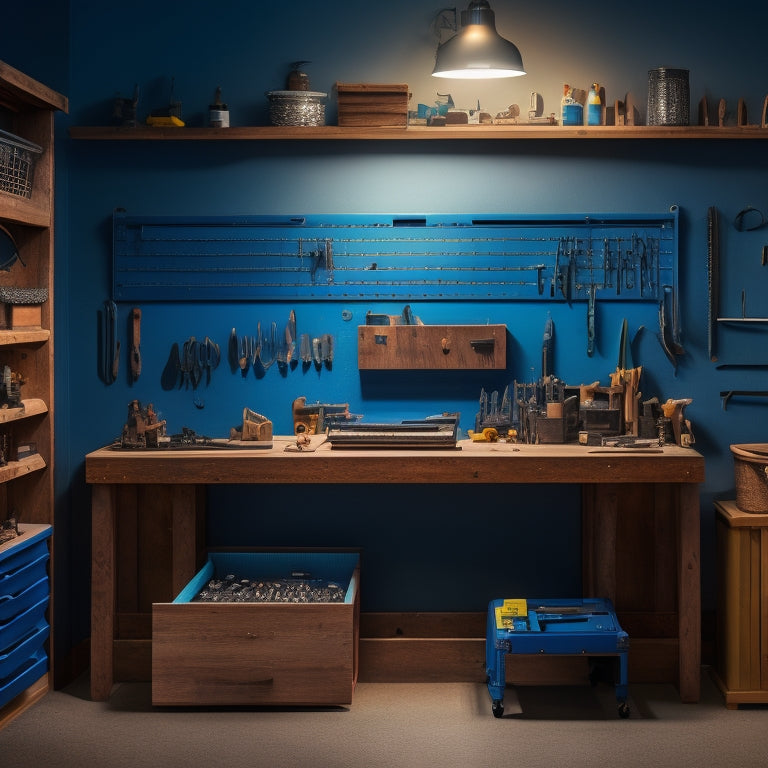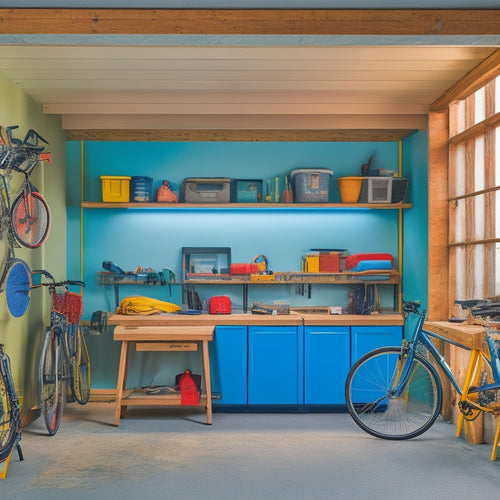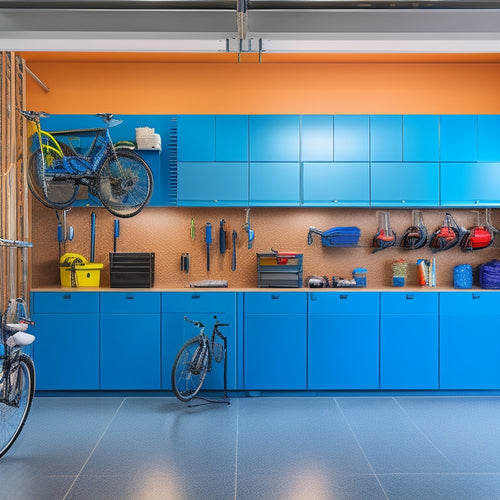
Revamp Your Toolbox: Masterful Organization Techniques
Share
I start by evaluating my tool collection, grouping similar tools by size, use, and condition. Then, I plan categorization, allocating space based on frequency of use. I create efficient layouts in logical and sequential order, optimizing workflow without sacrificing accessibility. To maximize efficiency, I utilize dividers, trays, and magnetic holders, keeping tools visible and neatly arranged. I also maintain a clean tool box, updating inventory records and applying rust prevention measures. By fine-tuning my tool sequence, I streamline task completion. Now, I'm ready to take my toolbox organization to the next level - and I'm excited to see what's next.
Key Takeaways
• Evaluate your tool collection methodically to categorize and allocate space based on size, use, and condition.
• Utilize dividers, trays, and foam inserts to optimize tool visibility, accessibility, and organization.
• Designate specific areas for different types of tools and optimize functionality to make the most of storage space.
• Arrange tools in sequence of task progression to minimize unnecessary movements and streamline workflow.
• Regularly clean and maintain your tool box to prevent dirt buildup, damage, and extend tool lifespan.
Tool Box Organization Strategies
I start by evaluating my tool collection methodically, taking into account the size, use, and condition of each tool to establish a solid foundation for my organization strategy.
Next, I plan my tool box categorization, grouping similar tools together and allocating space based on frequency of use. This guarantees that my most-used tools are easily accessible and prominently displayed.
I create efficient layouts, positioning tools in a logical and sequential order to optimize my workflow. By allocating space wisely, I can fit more tools in my box without sacrificing accessibility.
This thoughtful approach to tool box organization sets me up for success, allowing me to work more efficiently and effectively.
Maximizing Efficiency and Accessibility
By utilizing dividers, trays, foam inserts, and magnetic holders, you can keep your tools accessible and neatly arranged, streamlining your workflow and saving valuable time. This means I can easily spot the tool I need, thanks to enhanced tool visibility.
I've organized my tools into separate sections, providing extra security with foam inserts and enhancing visual structure with labels. Magnetic holders maintain swift availability, making it a breeze to grab the right tool at the right moment.
With optimized tool accessibility, I can focus on the task at hand, rather than wasting time searching for misplaced tools. By implementing these techniques, I've transformed my toolbox into a hub of efficiency, allowing me to work smarter, not harder.
Maintaining Tool Box Integrity
To prevent dirt buildup and potential damage, regularly clean your tool box, wiping down surfaces and removing any debris that may have accumulated. This vital step maintains tool box integrity and guarantees peak performance.
Here are three essential habits to adopt:
-
Update inventory records consistently to make sure tool box contents align with current project requirements.
-
Care for tools by applying rust prevention measures to extend their lifespan and safeguard against corrosion.
-
Avoid common hazards like overloading drawers, neglecting tool maintenance, and common errors to maintain a well-arranged tool box.
Efficient Tool Retrieval and Flow
With a well-maintained tool box, I can now focus on optimizing the retrieval process, making sure that every tool is easily accessible and positioned to match the flow of my projects.
I start by arranging tools in the sequence of task progression, streamlining my workflow and minimizing unnecessary movements. This workflow optimization enables me to access frequently used tools quickly, boosting project efficiency.
I also guarantee tool accessibility by positioning instruments in a logical order, making it easy to find what I need when I need it. By fine-tuning my tool sequence, I can complete tasks more efficiently, saving time and energy.
With this system in place, I can tackle projects with confidence, knowing that my tools are always within reach.
Optimizing Tool Box Functionality
I evaluate each tool to create a thoughtful plan for organization, designating specific areas for different types of tools and recognizing the unique benefits of portable versus stationary tool boxes. This helps me optimize tool box functionality and make the most of my storage space.
Here are three key strategies I use:
-
Compact storage: I store less-used tools in compact yet accessible places, making room for frequently used tools in easy-to-reach areas.
-
Unique qualities: I recognize the unique qualities of portable versus stationary tool boxes and choose the right one for each project, considering factors like mobility and stability.
-
Logical arrangement: I neatly arrange all contents for easy access as needed, facilitating keeping tools in order with logical arrangements and proper identification through labels.
Mastering Tool Organization Techniques
By categorizing tools into task-specific groups and assigning a designated home for each, I can master the art of tool organization and guarantee that every item has its place within the toolbox.
This approach enables me to utilize tool storage efficiently, ensuring that frequently used tools are within easy reach.
To further optimize my toolbox, I implement organization tips such as dividing tools into separate sections and using labels to enhance visual structure.
I also utilize dividers, trays, and foam inserts to keep tools accessible and neatly arranged.
Streamlining Your Workspace Environment
Organizing my toolbox is just the first step; now it's time to take a closer look at the workspace itself, ensuring that every tool has a designated spot and every inch of space is utilized efficiently. This is where workspace optimization comes into play, and I'm excited to share my strategies for maximizing productivity.
Here are three essential steps to follow:
-
Clear the clutter: Remove any unnecessary items from your workspace, keeping only the essentials within easy reach.
-
Designate zones: Divide your workspace into zones, each dedicated to a specific task or tool, to streamline your workflow.
-
Optimize your layout: Arrange your tools and equipment in a way that minimizes movement and maximizes efficiency, allowing you to focus on the task at hand.
Frequently Asked Questions
How Do I Deal With Oversized Tools That Don't Fit in My Toolbox?
"I tackle oversized tools by exploring tool alternatives, like folding or compact versions, and implementing storage solutions like wall-mounted hooks, ceiling racks, or separate shelving units to keep them organized and easily accessible."
Can I Customize My Toolbox to Fit Specific Project Requirements?
I customize my toolbox to fit specific project requirements by incorporating modular compartments and adaptive inserts, allowing me to tailor my organization strategy to each project's unique needs and optimize my workflow.
What's the Best Way to Organize Cordless Tool Batteries and Chargers?
As I open my toolbox, I envision a tidy haven where every item has its place. To organize cordless tool batteries and chargers, I create a designated Battery Station with Charge Caddies, separating them by type and voltage, and labeling each slot for easy identification.
How Can I Prevent Tools From Getting Lost or Misplaced During Projects?
To prevent tools from getting lost, I create tool shadows by tracing their outlines on a pegboard or foam insert, and use magnetic strips to store small items, ensuring everything has a designated spot.
Are There Any Specific Tool Organization Strategies for Small Workshops or Garages?
I'm drowning in a sea of tools! To avoid chaos in my small workshop or garage, I allocate zones for specific tasks, categorize tools by function, and designate a "launching pad" for frequently used items, ensuring everything has its perfect place.
Related Posts
-

7 Essential Foldable Workbenches for Garages
When selecting a foldable workbench for your garage, you'll want to contemplate factors such as space-saving design, ...
-

Adjustable Modular Shoe Racks for Versatility
Adjustable modular shoe racks are your go-to solution for versatile and organized footwear storage. These racks maxim...
-

Top Garage Storage Bins for Organization and Style
You can enhance your garage's style and organization with the right storage bins. Top brands like Rubbermaid, Suncast...


